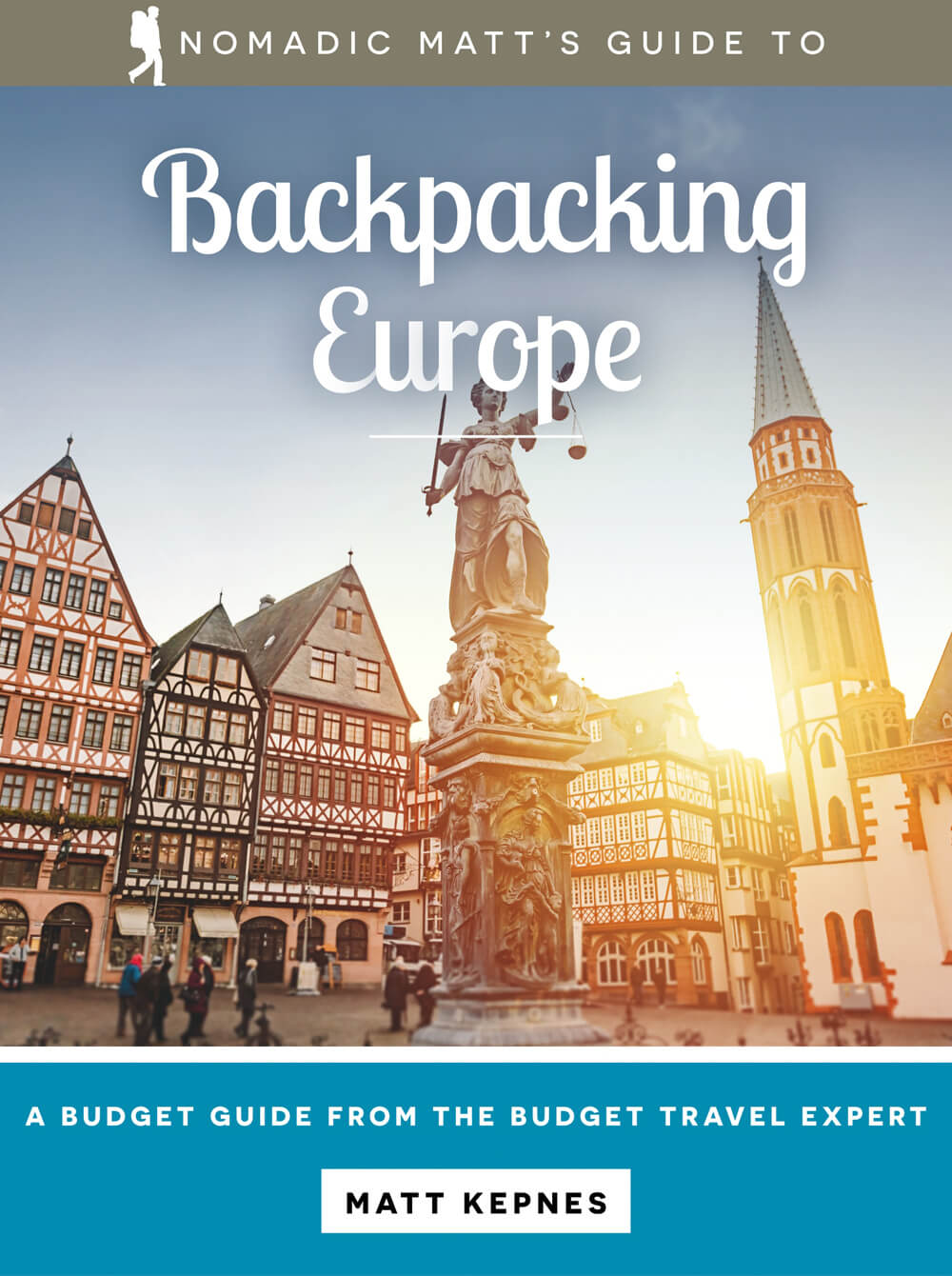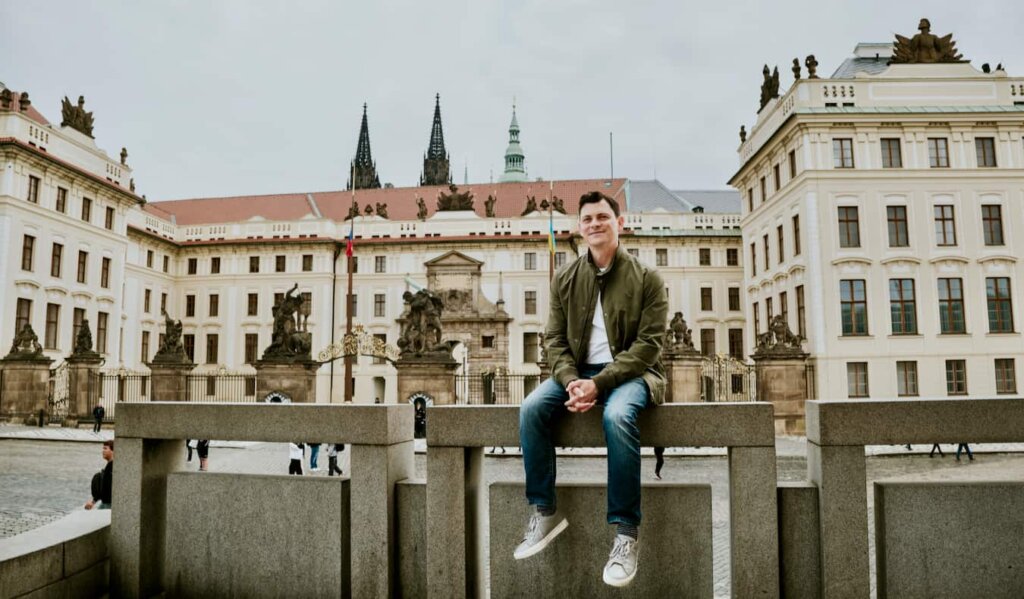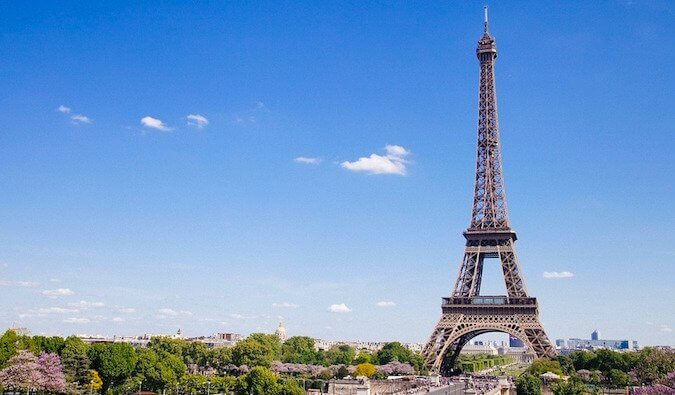Bosnia & Herzegovina Travel Guide
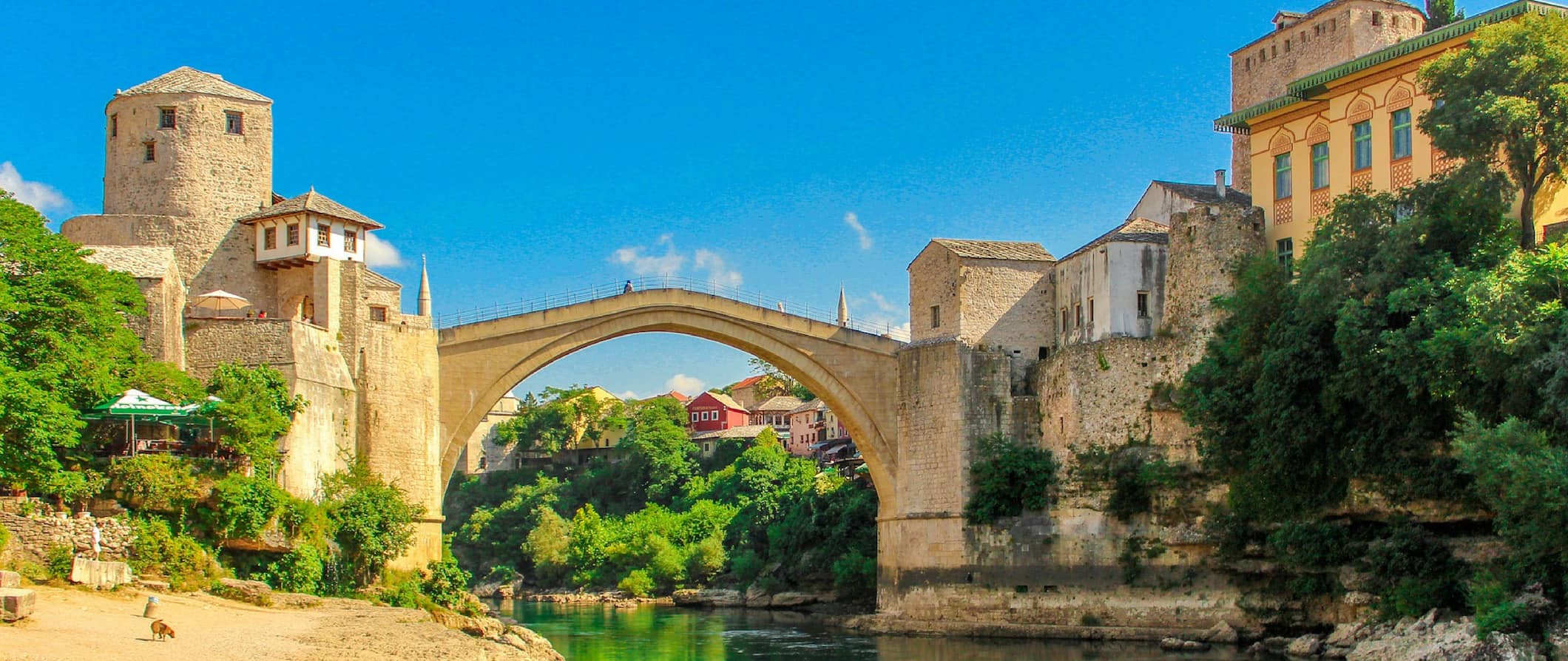
Often overlooked because the country’s name is still synonymous with the Yugoslavian War of the 1990s, Bosnia & Herzegovina deserves your attention. It’s one of the most underrated destinations in Europe.
Not a lot of people backpack or travel through the country but it is rich in history, culture, and natural beauty.
Three major religions (Islam, Roman Catholic, and Serbian Orthodox) all come together in this small area to form a vibrant blend of cultures. You’ll hear the Muslim call to prayer over the minarets one minute, and church bells ringing from a nearby church the next.
Watch skilled divers jump from the iconic bridge in Mostar, enjoy some hookah at one of Sarajevo’s sidewalk cafes, take a dip in the turquoise pools below the cascading Kravica Falls, or raft down the Tara Canyon, the deepest canyon in Europe.
The country (especially the capital) has become more popular in recent years thanks to increasing tourism in the region and cheaper prices but you can still catch it before the big crowds come!
This travel guide to Bosnia & Herzegovina will help you plan your trip, save money, and make the most of your time in this off-the-beaten-path destination!
Click Here for City Guides
Top 5 Things to See and Do in Bosnia & Herzegovina
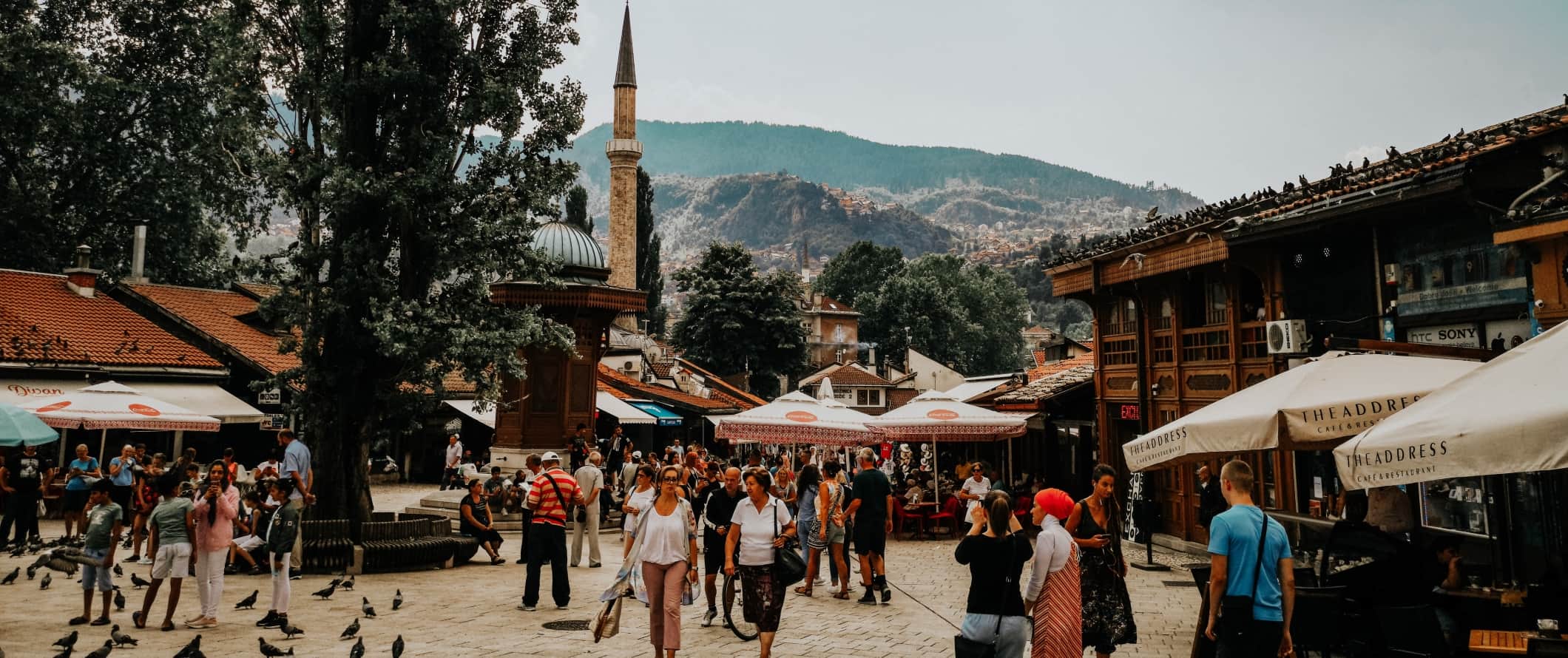
1. See Sarajevo
Bosnia’s capital has a distinct “east meets west” vibe. Perched alongside the Miljacka River and surrounded by mountains, the city is both scenic and historic. It is well-known for its cultural diversity and is sometimes referred to as the Jerusalem of Europe; within the city you can sometimes find a mosque, a catholic church, and a synagogue all within a few blocks. Wander the colorful Bascarsija Square for excellent people-watching, and while you’re there visit the iconic Sebilj Fountain. This Ottoman-style wooden fountain was originally built in 1753 and relocated in 1891. Local legend claims that if you drink from the fountain, you will always return to Sarajevo. Enjoy some hookah, take the cable car to the top of Mount Trebevic for incredible views, and visit the Bašcaršija historic market for some snacks and more people-watching.
2. Check out Mostar
Mostar is a medieval city best known for its 16th-century bridge, which is a UNESCO World Heritage Site, straddling the Neretva river. The bridge is constructed in the Ottoman style, and on warm days you will often spot locals jumping off into the river. Mostar’s name comes from the word mostari, which translates to bridge keeper (the original bridge was crucial to an important trade route). Strolling through Mostar is like traveling back in time, with its picturesque cobblestone streets and incredible architecture. Explore this historic town and see the ancient Ottoman homes and panoramic views from the local mosque. It’s one of the best cities in the country.
3. Visit the Pliva Lakes
The Pliva Lakes are two emerald lakes surrounded by wooded mountains, just outside Jajce. The area is home to the famous Pliva watermills, unique wooden watermills that were traditionally used to grind wheat. With rivers, waterfalls, and easy bike paths, outdoor lovers flock here to swim, paddle, bike, and explore. Surrounded by amenities like picnic tables, fire pits, kayak rentals, cafes, and playgrounds, the lakes are an ideal place to enjoy a day surrounded by nature. The lakes are formed from the widening Pliva River, which joins the Vrbas River and empties over the 22-meter (72-foot) Pliva Waterfall. For something unique, plan your visit to the annual waterfall jumping competition held here each August.
4. Marvel at the Kravica Waterfall
These marvelous cascades drop 25 meters (82 feet) into a bright emerald pool. During the springtime, the forests surrounding the pool and waterfall blossom into lush greenery, giving the area an oasis-like appearance. You can spend the day splashing in the swimming hole and swinging from the rope swing. Afterward, there’s a little café next to the water where you can grab a snack or a cold beer. Admission is 20 BAM, and swimming is allowed. To see the falls as part of a day trip from Mostar or Dubrovnik costs around 70 BAM.
5. Explore Trebinje
Trebinje is located just 30 kilometers (18 miles) from Dubrovnik, Croatia. Situated on a scenic lake ringed by mountains, it’s an excellent destination for natural beauty and interesting historical attractions. Here you can visit Austro-Hungarian ruins and ancient monasteries. During the warmer months take advantage of the many swimming spots along the banks of the Trebisnjica River, which winds its way slowly through the town. Stroll through the walled Old Town, which dates to the 17th century, or hike to the Serbian Orthodox Hercegovacka Gracanica monastery. Be sure to also treat yourself to some of the region’s famous wines!
Other Things to See and Do in Bosnia & Herzegovina
1. Ostrožac Fortress
This Gothic castle in the Una Valley is one of Bosnia’s most photogenic landmarks thanks to its brick torrents and stone wall running along the valley’s edge. Ostrožac has plenty to explore within its grounds, including a sculpture garden, ramparts, towers, and a manor house dating back to 1286. You can only visit the castle during the summer. Admission is 4 BAM.
2. Walk the Tunnel of Hope
Surrounded by Bosnian-Serb forces, Sarajevo had just one link with the outside world from 1992–1995: an 800-meter long (2,624-feet), 1-meter (3-feet) wide, 1.6-meter (5-feet) high tunnel connecting two houses on opposite sides of the airport runway. Eventually, the tunnel was equipped with rails to transport food and supplies. You can walk through part of the tunnel from the house at the western entrance while learning about the story of the siege through informational displays and videos. It’s an incredibly moving experience. The tunnel is open 9am-5pm daily and admission is 10 BAM.
3. Visit the National Museum of Bosnia & Herzegovina
The National Museum of Bosnia & Herzegovina in Sarajevo houses the Sarajevo Haggadah (a Jewish text) illuminated manuscript, which contains the illustrated text of the Passover Haggadah that goes with the Passover Seder. It’s one of the oldest Haggadah in the world, dating from 1350 and originating in Barcelona. In addition to Greek pottery and Roman mosaics, this museum is also home to a collection of stecci (medieval tombstones found scattered around the country). They started appearing in the 12th century for various Christian churches like the Bosnian Church, and most of them are inscribed with the extinct Bosnian Cyrillic alphabet. The entrance to the museum is 8 BAM.
4. See the Mehmed Pasha Sokolovic Bridge
Mehmed Pasha Sokolovic Bridge was built in Višegrad in 1571 and was designed by Mimar Sinan, the famous chief architect for the Ottoman Empire. He was the master builder behind both the Sehzade Mosque and the Süleymaniye Mosque in Istanbul, and this 11-arch bridge is the only confirmed work he completed in Bosnia & Herzegovina. It stretches 179 meters (587 feet) across the Drina River, and although it’s now closed to traffic, you can still appreciate its perfectly symmetrical beauty from the land.
5. See the watermills of Jajce
Jajce is known as the “city of falling water” thanks to its giant waterfall that connects the rivers Pliva and Vrbas. During the days of the Austro-Hungarian Empire (1867-1918), the small wooden huts stood on stilts over the gushing water used to ground local farmers’ wheat into flour. You can’t go inside, but you can see the huts up close as you explore.
6. Take a tour of Tito’s Bunker
On the bank of the river Neretva, just outside of Konjic and hidden behind a seemingly normal house, the once-forgotten bunker was built under the command of the Yugoslav revolutionary Josip Tito. It was kept secret for many years — even the construction workers were blindfolded until they arrived on site. The bunker cost billions of dollars to build and is now home to a contemporary art biennial called D-0 ARK Underground. You can only visit as a part of a guided tour with Visit Konjic, which costs 22 BAM.
7. See the Bosnian Pyramids
Located near Visoko, the Bosnian Pyramids are a set of four pyramids dating back 12,000 years ago that have perfect cardinal alignment, some reaching heights of 220 meters (721 feet). While most of the scientific community has debunked the theory that an ancient civilization built these structures, it’s a pretty amazing coincidence that they’re so aligned with the north. There are no official tours, so you’re free to explore on your own.
8. Visit Galerija 11/07/95
One of the most tragic events of the Yugoslavian War was the Srebrenica massacre, the largest genocide since World War II carried out by Bosnian Serb forces. With 8,372 victims, the gallery stands as a memorial to those that lost their life while also sharing survivor stories. It’s a powerful exhibition made up of photography, video footage, and audio testimonies. Admission is 12 BAM. An audio guide costs 3 BAM and a tour is 4 BAM.
9. Go whitewater rafting
Whitewater rafting on the Tara River Canyon, the deepest canyon in Europe, is one of the most exciting things to do in the country as you tackle rapids and fast-flowing water. Other than navigating 25 kilometers (15 miles) of white water, your guide will take you to waterfalls, springs, and swimming holes. I recommend Rafting Center Drina Tara. Their full-day tour costs 140 BAM and ends with a delicious traditional dinner of homemade goat pies, soup, grilled lamb, and drinks.
How to Stay Safe in Bosnia & Herzegovina
In Bosnia & Herzegovina, violent crime against tourists is rare. However, scams and pick-pocketing are common, usually on public transport and in the cities and especially around high-traffic areas in Sarajevo. Always keep an eye on your stuff and only take the cash you need for the day. You can read about common travel scams to avoid here.
If you want to go hiking, it’s essential you stick to marked trails only. Landmines can still be found here from the war so always stick to the trail.
Solo female travelers should generally feel safe here, however, the standard precautions apply (never leave your drink unattended at the bar, never walk home alone intoxicated, etc.).
If you experience an emergency, dial 122 for assistance.
The most important piece of advice I can offer is to purchase good travel insurance. Travel insurance will protect you against illness, injury, theft, and cancellations. It’s comprehensive protection in case anything goes wrong. I never go on a trip without it as I’ve had to use it many times in the past. You can use the widget below to find the policy right for you:
Where to Stay in Bosnia & Herzegovina
Like many other countries in this part of Europe, Bosnia & Herzegovina only has hostel accommodation in the cities. In the smaller less popular areas, you will find B&B style accommodation or campsites. Here are some of my favorite places to stay in Bosnia & Herzegovina:
- The Red Door Hostel Trebinje (Trebinje)
- Hostel Kucha (Sarajevo)
- Balkan Han Hostel (Sarajevo)
- Hostel Franz Ferdinand (Sarajevo)
- Villa Cardak (Mostar)
- Rooms Goa Mostar (Mostar)
Bosnia & Herzegovina Travel Costs
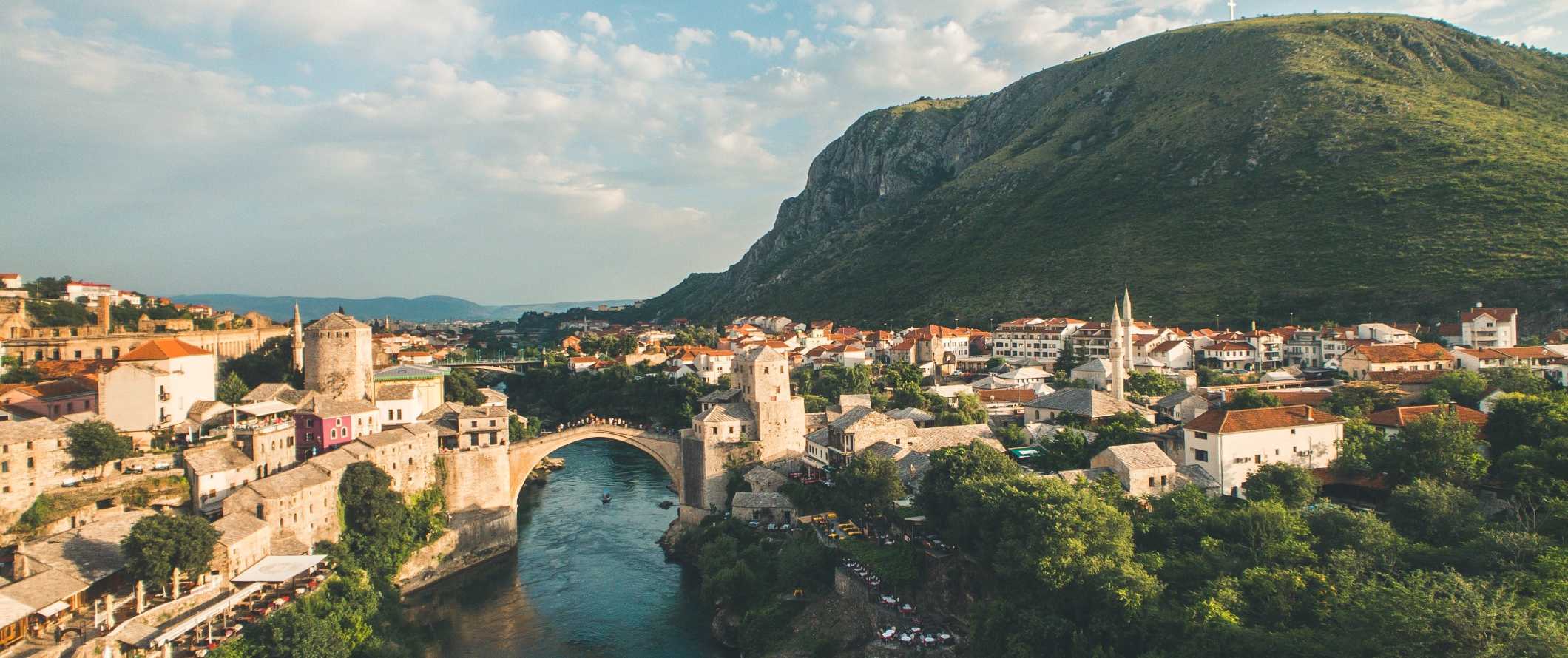
Accommodation
- Hostel Dorms – 19-28 BAM per night
- Hostel private rooms – 45-63 BAM per night
- Budget hotels – 35-63 BAM per night
- Airbnb private rooms – 30 BAM per night
- Airbnb apartments – 40 BAM per night
- Campsite – 10.50 BAM per night
Food
- Street food – 7 BAM
- Sit-down restaurants – 15-35 BAM
- Casual take-out places – 15 BAM
- Fast food (think McDonald’s) – 9 BAM
- Beer – 3 BAM
- Groceries for a week – 45-65 BAM
Bosnia & Herzegovina Suggested Budgets
Backpacker – 85 BAM Per Day
If you are backpacking in Bosnia & Herzegovina, this budgets gets you a hostel dorm, cooking your meals, sticking to mostly free activities (like free walking tours and hiking), and using public transportation to get around.
Midrange – 160 BAM Per Day
A mid-range budget covers staying in an Airbnb, eating out for all your meals at cheap local places, enjoying a few drinks, taking the occasional taxi, and doing more paid activities like museum visits or rafting.
Upscale – 275 BAM Per Day
On a “luxury” budget, you can stay in a hotel, eat out for all your meals, enjoy lots of drinks, take more taxis or rent a car, and do all the tours you desire. This is just the ground floor for luxury though!
Bosnia & Herzegovina Travel Guide: Money-Saving Tips
Bosnia & Herzegovina, like most of the region, is very budget-friendly. You’ll be able to eat, drink, and stay in comfortable accommodations without breaking the bank too much. However, I always love saving money when I can so here are some tips to help you save money when you visit:
Drink the tap water – Tap water within the cities is safe to drink, but not in the rural areas. Pick up a LifeStraw (a water bottle with a purifier) so you can cut down on your use of plastic bottles while saving money in the process.
Do a free walking tour – Both Sarajevo and Mostar have free walking tours available. They’re a great way to get familiar with the city and the culture. Just be sure to tip your guide at the end!
Wild camp – If you really want to save money in Bosnia & Herzegovina, bring your tent. You can pitch your tent on public land throughout Bosnia & Herzegovina.
Cook your own meals – Many hostels here include kitchen facilities, so if you want to save money, cook your own meals. It’s not glamorous but it’s cheap!
Stay with a local – Staying with a local via Couchsurfing is a great way to not only save money but to meet a knowledgeable local. Just make sure to send your requests early as there are not a ton of hosts here.
Walk everywhere – All of the major cities in Bosnia & Herzegovina are walkable, so skip the public transportation if you want to save a few extra dollars.
Enjoy the free spaces – There are plenty of free parks as well as many free hiking trails around the country. Save your budget and enjoy the outdoors!
How to Get Around in Bosnia & Herzegovina
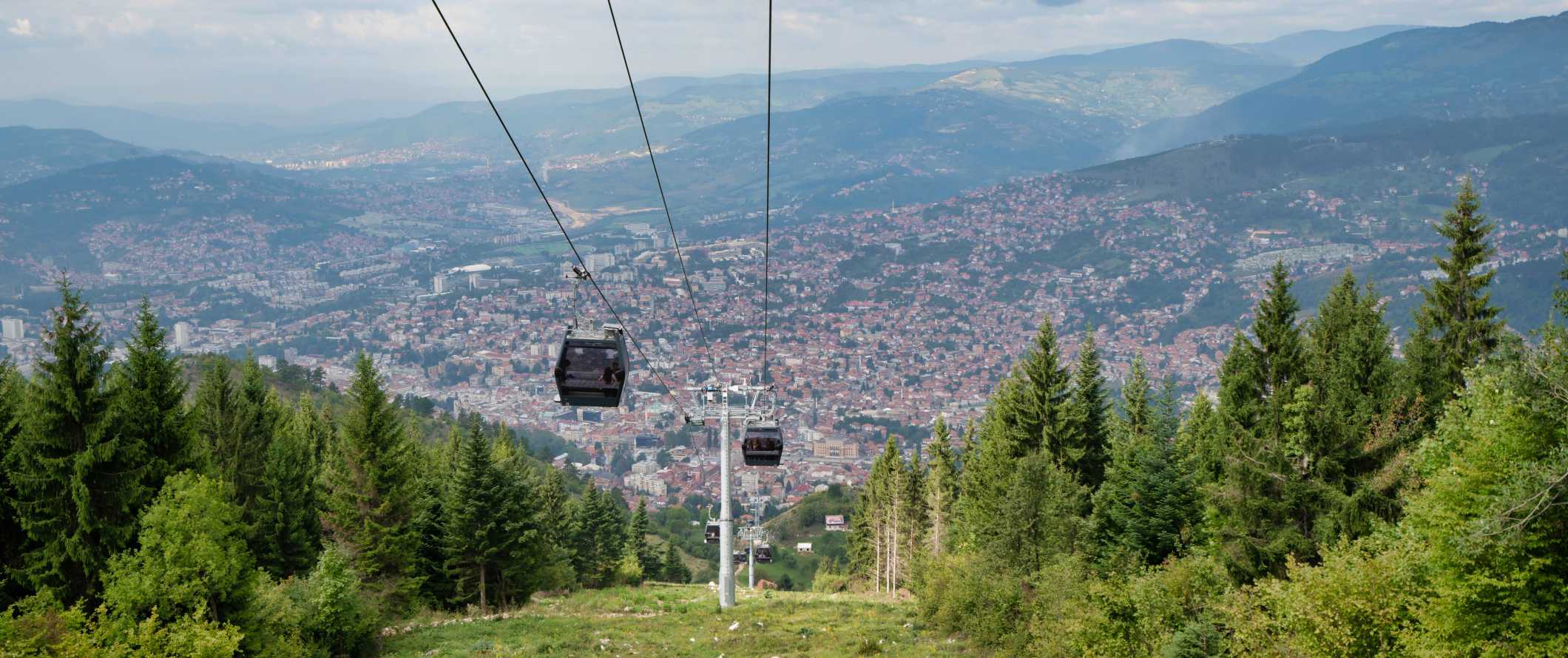
Public transportation – Most towns in Bosnia & Herzegovina are walkable. While public transportation prices vary by city, you can expect to pay around 2 BAM for a one-way ticket on buses, trams, or trolleybuses.
Taxi – If you need to take a taxi, prices start at about 3 BAM and cost about 1.60 BAM for every additional kilometer. While affordable, they do add up so skip them if you can.
Bus – There is an extensive network of long-distance intercity and international buses. Between towns, it’s normally easy enough to wave down any bus. Reservations are sometimes necessary for overnight routes or at peak holiday times but not during the day. The biggest companies include:
- Autoprevoz
- Globtour
- Centrotrans
A bus from Sarajevo to Mostar takes 2.5 hours and costs around 11 BAM, while Sarajevo to Trebinje takes nearly 10 hours and is about 40 BAM. Mostar to Jajce is a 4.5-hour journey and costs about 27 BAM. Try to book a day in advance when possible as seats do fill up quickly in the summer season.
It is worth noting that if you buy a round trip with the same company, you can save yourself up to 60% compared to buying two single tickets. Also, if you need to put luggage in the hold, companies will often charge you an additional 2-4 BAM. (It’s common in this region to charge for the luggage hold.)
Train – Trains do operate in Bosnia & Herzegovina, however, they are outdated and extremely slow. I do not recommend using them. Take the bus instead.
Flying – No budget airlines offer domestic flights within Bosnia & Herzegovina.
Car rental – Car rentals can be found for around 40 BAM per day for a multi-day rental. Renters must be at least 21 years old and have an International Driving Permit (IDP). For the best car rental prices, use Discover Cars.
Hitchhiking – Hitchhiking in Bosnia & Herzegovina is generally safe, but it’s not for everyone and you should use caution in the region. HitchWiki is the best website for hitchhiking info.
When to Go to Bosnia & Herzegovina
In general, May through to October is the best time to visit Bosnia & Herzegovina as these are the warmest months. The temperature hovers around 31°C (87°F) and rarely drops below 17°C (62°F).
Even in the summer months, Bosnia & Herzegovina doesn’t get a ton of tourism traffic. A lot of people will take a day trip to Mostar from Croatia, but you don’t have to worry too much about overcrowding in the rest of the country.
Unlike other Mediterranean countries, Bosnia & Herzegovina doesn’t have a whole lot of coastal areas to enjoy. If you’re here mostly for hiking or sightseeing, the cooler spring/fall temperatures might suit you better.
Winters here can be harsh and they often last from November to March. Temperatures often drop below freezing, and snowfall is common. I’d skip a winter visit.
Bosnia & Herzegovina Travel Guide: The Best Booking Resources
These are my favorite companies to use when I travel. They consistently have the best deals, offer world-class customer service and great value, and overall, are better than their competitors. They are the companies I use the most and are always the starting point in my search for travel deals.
- Skyscanner – Skyscanner is my favorite flight search engine. They search small websites and budget airlines that larger search sites tend to miss. They are hands down the number one place to start.
- Hostelworld – This is the best hostel accommodation site out there with the largest inventory, best search interface, and widest availability.
- Booking.com – The best all around booking site that constantly provides the cheapest and lowest rates. They have the widest selection of budget accommodation. In all my tests, they’ve always had the cheapest rates out of all the booking websites.
- HostelPass – This new card gives you up to 20% off hostels throughout Europe. It’s a great way to save money. They’re constantly adding new hostels too. I’ve always wanted something like this and glad it finallt exists.
- Get Your Guide – Get Your Guide is a huge online marketplace for tours and excursions. They have tons of tour options available in cities all around the world, including everything from cooking classes, walking tours, street art lessons, and more!
- The Man in Seat 61 – This website is the ultimate guide to train travel anywhere in the world. They have the most comprehensive information on routes, times, prices, and train conditions. If you are planning a long train journey or some epic train trip, consult this site.
- Trainline – When you’re ready to book your train tickets, use this site. It streamlines the process of booking trains around Europe.
- Rome2Rio – This website allows you to see how to get from point A to point B the best and cheapest way possible. It will give you all the bus, train, plane, or boat routes that can get you there as well as how much they cost.
- FlixBus – Flixbus has routes between 20 European countries with prices starting as low 5 EUR! Their buses include WiFi, electrical outlets, a free checked bag.
- SafetyWing – Safety Wing offers convenient and affordable plans tailored to digital nomads and long-term travelers. They have cheap monthly plans, great customer service, and an easy-to-use claims process that makes it perfect for those on the road.
- LifeStraw – My go-to company for reusable water bottles with built-in filters so you can ensure your drinking water is always clean and safe.
- Unbound Merino – They make lightweight, durable, easy-to-clean travel clothing.
- Top Travel Credit Cards – Points are the best way to cut down travel expenses. Here’s my favorite point earning credit cards so you can get free travel!
GO DEEPER: Nomadic Matt’s In-Depth Budget Guide to Europe!
There’s a lot of free information online but do you want to spend days searching for information? Prob not! That’s why guidebooks exist.
While I have a lot of free tips on Europe, I also wrote an entire book that goes into great detail on everything you need to plan a trip here on a budget! You’ll get suggested itineraries, budgets, even more ways to save money, my favorite restaurants, prices, practical information (i.e. phone numbers, websites, prices, safety advice, etc etc), and cultural tips.
I’ll give the insider view of Europe that I got from years of traveling and living here! The downloadable guide can be used on your Kindle, iPad, phone, or computer so you can have it with you when you go.
Click here to learn more about my book on Europe!
Bosnia & Herzegovina Travel Guide: Related Articles
Want more tips for your trip? Check out all the articles I’ve written on Europe and continue planning your trip:

